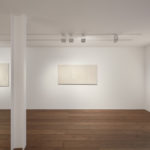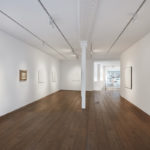“I let the light of white emerge. I wanted it all to become as weightless as possible, transparent,
almost indecipherable.
Fascinated by Zen Indian inks,
I worked on white canvases with
graphite and watercolour achieving the luminosity that became the principle of my painting.
The light comes from within the
transparencies, from within the painting
and projects outwards.”
Riccardo Guarneri
Riccardo Guarneri, Angolare più luminoso, 2017
Slowing Time
23 February 2018 – 10 April 2018
Following on from being one of the stand out artists in Christine Macel’s curated exhibition Viva Arte Viva at last year’s Venice Biennale, the 84 year old Florentine Riccardo Guarneri will be having his first solo exhibition in the UK at Rosenfeld Porcini.
Slowing Time will showcase Natura Morta by Giorgio Morandi and Ironia by Fausto Melotti. These will illustrate how, notwithstanding Morandi is a figurative painter and Melotti a sculptor, their poetic sensibilities and artistic objectives are similar to Guarneri’s abstraction. The three artists’ works present a conscious absence of emphasis and a lengthy meditation is necessary to absorb their unique qualities. The main body of the exhibition, however, will feature a selection of iconic paintings spanning over 50 years of Riccardo Guarneri’s practice.
A musician as well as a visual artist, from his debut in the early ‘60s Guarneri focused on a radically visual investigation built around the idea that mark, color and light constitute the intrinsic essence of a painting. The works selected for the exhibition document the formidable stylistic integrity of an author who has devoted his whole trajectory to a continuous variation on a theme.
An independent figure as much as a precursor of the international contemporary artistic research which blossomed through the ‘60s, Guarneri concentrated his study on the essential aspects of painting, liberating it from any representational concern and descriptive temptation, yet eschewing the conceptual dogma at the core of minimalism in favour of a lyrical abstraction.
Characterized by an apparent stillness coupled with a rigorous weightlessness, Guarneri’s works conjure up a natural tension as his imperceptibly asymmetrical geometric structures confront a light that consumes and unravels them. Subtle variations of graphite handwriting, semantically meaningless but visually substantial, confer texture and enhance the rhythm of nuances.
Though certain critics suggested a parallel with the sheer simplification of the Color-field painters, Agnes Martin perhaps presents a far more apt comparison to Guarneri’s Zen-like approach and lyricism. Similarly to her, Guarneri’s line only carries the illusion of being something definitive. His pastel colours convey softness and the dissolving of one into another reinforces a sense of tenuous boundaries.
Hardly perceptible, the subtle shades and impalpable tones of Guarneri’s paintings deter photographic reproduction today as they did almost sixty years ago. At odds with contemporary art’s obsession with instant consumption and over-reliance on digital imagery, his whole repertoire, encompassing geometric structures and warmer, unconstrained spots of colour, can be seen as an ode to ‘listening’ as the ultimate act in allowing the melody hidden within the work to permeate us.
Entering Guarneri’s studio feels like stepping back in time. Crayons, water colours, rubbers, pencils and rulers recall the romantic, pure universe inhabited by children as they make their initial steps into making art. Guarneri’s sophisticated paintings are obtained with the simplest of materials. His absolute faithfulness to his medium is a testament to both the timelessness of painting and its extraordinary capacity for continual reinvention.
Riccardo Guarneri was born in 1933 in Florence, where he lives and works. After a short period, where he was preoccupide with the painterly gesture, in 1962 he starts a research based on line and light that becomes his principal object of study within a minimal geometric structure. He starts with his first solo exhibition at The Hague in 1960. He takes part in The Biennale in 1966 (with Agostino Bonalumi and Paolo Scheggi) and the exhibition “Weiss auf Weiss” at Bern Kunstalle; he participate in the Biennial of Paris in 1967 in the “New Artists” section. In 1972 he holds his first anthological exhibition at the Westfalischer Kunstverein in Munster. He takes part in the Quadriennale of Rome in 1973 and 1986. In 1981 at the Palazzo delle Esposizioni in Rome he exhibits his works in “Linee della ricerca artistica in Italia 1960-1980”, an exhibition that in 1997 is featured at the Kunsthalle of Cologne “Abstrakte Kunst Italiens ‘60/’90”. In 2004 he participate in “Mostra Antologica” in Palazzo Pitti in Florence. In 2007 he is feature in “Pittura Analitica anni ‘70” at the Palazzo della Permanente in Milan. In 2008 he is one of the artists in the exhibition “Pittura Aniconica” in the Houseof Mantegna in Mantua; in 2011 he takes part in “Percorsi riscoperti dell’arte italiana – VAF-Stiftung 1947-2010” at the Mart Museum in Trento. He has taught painting in Carrara, Bari, Florence and the Venice Academy of Art. In 2017 he is included in the 57th International Art Exhibition at the Venice Biennale ‘Viva Arte Viva’.
37 rathbone street london w1t 1nz | +44 2076371133 | www.rosenfeldporcini.com | info@rosenfeldporcini.com
- Riccardo Guarneri – Rosenfeld Porcini – London
- Riccardo Guarneri – Rosenfeld Porcini – London



